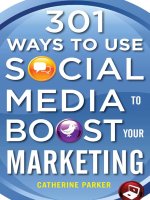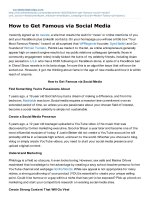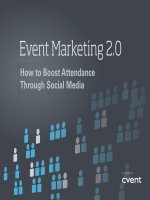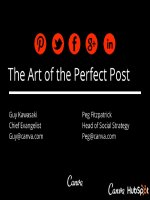Secrets to a Perfectly Crafted Social Media Post
Bạn đang xem bản rút gọn của tài liệu. Xem và tải ngay bản đầy đủ của tài liệu tại đây (80.29 KB, 3 trang )
inc.com
/>cid=em01020week45&nav=su
Secrets to a Perfectly Crafted Social Media Post
What you say is important. But so is how and when you say it.
kevygee via Flickr
You work hard to create great content. Now you need people to act ually see what you create.
That means optimizing your social media strategy across different platforms. But how?
The following is drawn from research conducted by Compendium, a cont ent marketing platform
that helps organizations easily distribute branded cont ent to a variety of marketing channels.
(They provide a number of free content marketing resources here.)
Of course the better you know your audience the better you can tailor your social media marketing
strategy to meet their needs. So your results may vary, but the following is a great place to start.
How to Say It
1. Is there an ideal social message length?
Twitt er: One to five words is the ideal length for B2C companies; consumers appreciate short and
sweet. Where B2B is concerned, 11-15 words is ideal; any shorter and the message may not
provide enough information to draw them in.
LinkedIn: For B2C, 21-25 words is the ideal length. For B2B, 16-25 is best.
2. Do question marks draw interest or spark conversations?
Twitt er: Messages receive 52% fewer clicks if a quest ion mark is included for B2C, 39% fewer for
B2B.
LinkedIn: B2C messages receive 45% fewer clicks, B2B 25% fewer.
Clearly people tend to use Twitter and LinkedIn to find answers, not answer questions. Facebook
may be a better option for surveys and questions.
3. Are exclamation marks effective?
Twitt er: Using exclamation marks results in 8% fewer clicks on Twitter for B2C, 15% fewer on
B2B. Evidently hyperbole or breathless enthusiasm isn't helpful on Twitter.
LinkedIn: B2C messages with exclamation marks get 27% more clicks for B2C and 26% more for
B2B. Exclamation marks work but as Compendium notes, "Only use exclamation marks when
relevant if everything is exciting, nothing is exciting."
4. Are hashtags ef fective?
Twitt er: For B2C companies, messages on Twitter receive 82% fewer clicks if they include a
hashtag, but hashtagged messages are 193% more effective for B2B. B2B followers appreciate
relevant hasht ags; B2C followers do not.
LinkedIn: 20% fewer clicks for B2C, 56% more clicks for B2B. LinkedIn users are able to follow
conversations using hashtags and for B2B connections, they work.
5. Does using a number really make a diff erence?
Conventional wisdom says social media posts (and blog posts and article titles) with numbers in
them generate more clicks. The results are mixed:
Twitt er: 3.5% more clicks for B2C, 50% more clicks for B2B.
LinkedIn: No real effect for B2C or B2B.
Use numbers when they're appropriate, especially for Twitter B2B. But otherwise don't force them
because they don't make much difference.
When To Say It
1. Best days of the week
Twitt er: Mondays and Wednesdays yield more clicks for B2C, Wednesdays for B2B.
LinkedIn: Sharing content on Mondays generates more B2C clicks than any other day of the
week; for B2B, the best day is Sunday.
Share regularly, but save your best stuff for the prime days.
2. Best hours of the day
Twitt er: Between 10 a.m. and noon. After about 2 p.m. there is a significant drop, probably
because many people check their Twitter stream after they settle in and are less likely to check
near the end of the day.
LinkedIn: From 9 a.m. through lunchtime.
Facebook: Lunchtime and later afternoon. Schedule Facebook content for the last half of the
workday. That is especially true for B2C, which typically shows heavy activity towards the end of
the workday.
3. Best minutes of the hour
Twitt er: Tweets are generally read during the top and bottom of the hour, whether B2C or B2B.
(Possibly at break time or between meetings?)
LinkedIn: For B2C, content is generally read evenly through the hour, but content shared in the
first 10 to 15 minutes performs relatively poorly. For B2B, the top and bottom of the hour is best.
Jeff Haden learned much of what he knows about business and technology as he
worked his way up in the manufacturing industry. Everything else he picks up from
ghostwriting books for some of the smartest leaders he knows in
business. @jeff_haden









